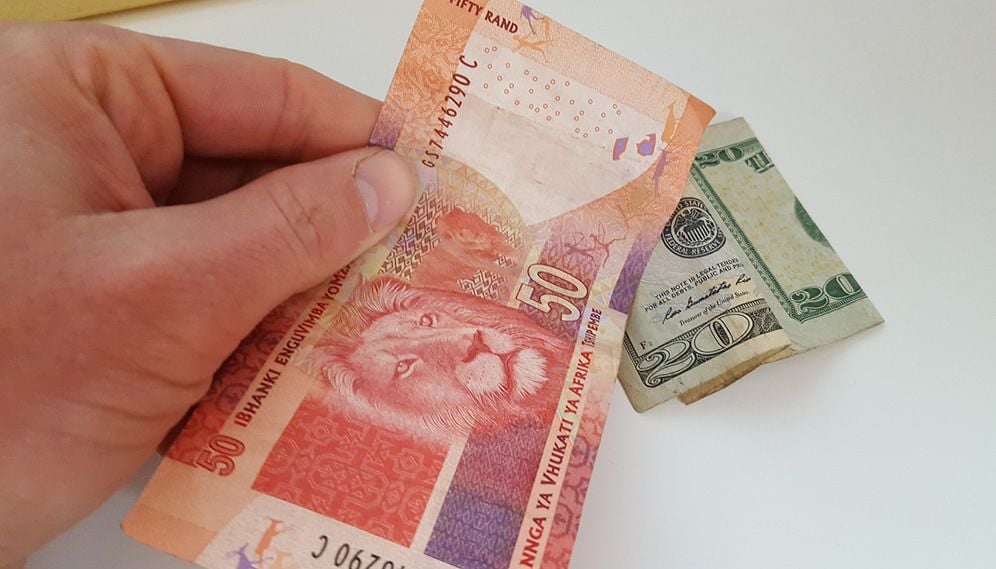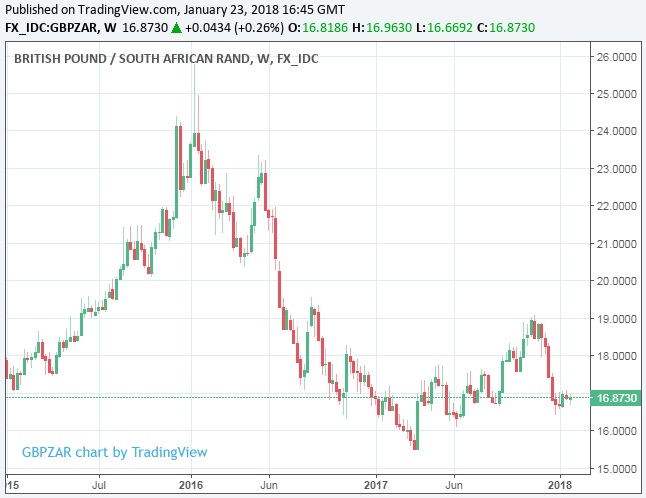Rand Forecasts Upgraded at Barclays, no Moodys Downgrade Expected
- Written by: James Skinner
-

As Ramaphosa pushes for reform and speculation mounts over President Jacob Zuma's departure, analysts are becoming more optimistic about South Africa.
Analysts at Barclays have said this week they do not see South Africa suffering a downgrade to its local currency sovereign debt rating from Moodys. The call owes itself to the ANC’s Cyril Ramaphosa having hit the ground running with efforts to reform South Africa early on in his party presidency.
In light of this assumption, the South African Rand is expected to enjoy heightened levels of support over the coming months, leading analysts at Barclays to upgrade their 2018 forecasts for the currency.
After having won the ANC leadership election in December, Ramaphosa has shot straight out of the gate efforts to clean up South African politics and governance within state owned enterprises.
“Cyril Ramaphosa has moved swiftly towards delivering on his promises to root out corruption from government, support the independence of state institutions, fix the prevailing governance and other challenges at poorly performing state-owned enterprises and prepare the ruling party for the upcoming 2019 elections,” says Nikolaos Sgouropoulos, an analyst at Barclays.
Sunday saw the board of state power utility Eskom, which is beset by cash-flow problems, told to make way for their replacements. This was a move instigated by Ramaphosa’s camp and is a significant event for the Rand and South Africa as a whole.
The South African Treasury is on the hook for as much as ZAR 350 billion (£21 billion) of Eskom’s debt, given government guarantees extended to the energy company in recent years, which means Eskom has also been a major issue for ratings agencies.
“We believe that the decisive action taken at Eskom opens the door for more decisive action with respect to the fiscus. This, together with the recent bold moves by the country’s crime-fighting institutions... is likely to address rating agencies’ concerns about institutional independence and the potential impact of rising contingent liabilities,” Sgouropoulos writes, in a recent note to clients.
“We thus no longer expect a downgrade by Moody’s in March,” adds the analyst.
South Africa has suffered a slew of ratings downgrades during the tenure of Jacob Zuma's presidency as a poor policy mix ultimately saw economic growth stutter; and all eyes were on Moody's impending ratings verdict with many seeing a downgrade as effectively canning the investment status of South Africa to foreign investors.
Corruption in politics and governance at state owned enterprises were top of the agenda for the reformist Ramaphosa during the ANC’s leadership election last year as the first step to restoring South Africa's once highly-envied investment status.
The Rand has gained some 3% on the US Dollar in January alone as the greenback weakens and investors respond to the brightening outlook in South Africa.

Above: USD/ZAR rate at daily intervals. A falling rate means a stronger Rand, or weaker Dollar.
Advertisement
Get up to 5% more foreign exchange by using a specialist provider to get closer to the real market rate and avoid the gaping spreads charged by your bank when providing currency. Learn more here.
But the Budget Deficit is Still Important
December's ANC leadership ballot came closely on the heels of a decision by Standard & Poor’s to downgrade South Africa’s debt rating to “junk”, creating a chaotic economic and financial backdrop to the vote.
Standard & Poor’s cited, among other things, weak economic growth, falling tax receipts and insufficient progress by the government in its efforts to rein in spending as grounds for its decision.
South Africa’s budget deficit has been seen rising above the 4% of GDP threshold during 2017 for these very reasons.
Although not a significant deficit by developed market standards, for an emerging market facing multiple economic challenges, it has been a concern for ratings agencies.
A February 21 budget statement that sets out a credible plan for reducing the deficit will still be important in determining whether the country is able to keep its investment grade rating.
Moody’s is the last remaining agency to have South Africa’s local currency bonds rated as investment grade although this rating is under review and, until now, was seen as something that could be withdrawn as soon as March.
Should South Africa suffer a downgrade, many institutional investors could be forced into selling their South African bonds, which would push government borrowing costs higher and put downward pressure on the Rand as foreign investors flee the country.
“As we no longer expect a rating downgrade by Moody’s in March we see no meaningful catalyst for material near-term rand depreciation. As such, we are marking our USDZAR forecasts to market,” Sgouropoulos says.
“ZAR’s significant appreciation, coupled with long positioning and elevated market expectations ahead of the February budget are a risk to this view, however.”
Barclays now forecasts the USD/ZAR rate will finish the year at 12.00, which is an upgrade from its earlier projection of 12.40 in time for year-end. If Sterling was to hold its current 1.3955 level against the Dollar until year-end, this would mean a Pound-to-Rand exchange rate of 16.74.

Above: Pound-to-Rand rate at weekly intervals. Captures Rand strength since December.
Early Exit for Zuma?
Progress toward reforming Eskom comes alongside increasing speculation that South Africa’s President of state, the scandal ridden Jacob Zuma, could be forced to step down within the month.
“Positive developments in Eskom’s governance as well as the future of President Zuma, discussed at the ANC NEC over the weekend, helped spur both the rand and bonds yesterday,” says Gordon Kerr, an interest rate strategist at Rand Merchant Bank.
“We expect bonds to remain mostly range bound, strengthening slightly after the auction as investors watch for headlines today waiting for further hints on the future of President Zuma.”
Earlier in January South Africa’s parliament began working to formalise the process of removing a sitting president, which gave the initial impetus to hopes that Zuma could soon be removed from office.
After being the focus of multiple corruption allegations during recent years, both domestic and international investors had all but lost confidence in Jacob Zuma and South African politics.
Zuma’s departure from the Presidency is seen as key to shoring up confidence in the ruling ANC party ahead of the 2019 election, as well as restoring lost confidence in South Africa as place where international investors can do business.
“The ANC's National Executive Committee has asked Zuma to resign...Even if things aren't going as fast as some observers suspect, it is still to be hoped that such a troubled president will no longer be able to push through such an extreme budget that even the last rating agency would have to lower South Africa’s credit rating to junk status,” says Ulrich Leuchtmann, head of G10 FX strategy at Commerzbank.
Foreign Investment Already Returning?
Already international investors are flooding back into South African stocks to take advantage of renewed optimism around the economy and its future.
Foreign direct investment into South Africa was negative in the third quarter of 2017, the most recent that data is available for, meaning more investors sold assets and left the country than bought assets and came in during the period.
“While slower local (and global) growth and the turn in the commodity super-cycle likely played some part, the deterioration in governance and “reforms working in reverse” were crucial drivers,” says Kiran Kowshik, an emerging markets FX strategist at UniCredit Bank.
The amount of investment leaving South Africa during the third quarter of last year was equivalent to 1.7% of the country’s annual economic output.
This marked a continuation of a long five-year trend that has seen a foreign direct investment surplus, of 1.5% of GDP in 2012, converted into a currency-clobbering deficit.
“If reforms move in the right direction, there is a possibility that such FDI flows into South Africa might be revived after several years of deterioration. This could be an additional source of support for the rand over and above the “fast” or “speculative” money flows,” Kowshik writes, in a briefing Tuesday.
Kowshik and the strategy team at UniCredit are also increasingly optimistic in their outlook for the Rand.
They are currently reviewing their forecasts but have already tipped clients that the USD/ZAR rate could fall below the 12.00 threshold, possibly as low as 11.70 in the coming days.
Advertisement
Get up to 5% more foreign exchange by using a specialist provider to get closer to the real market rate and avoid the gaping spreads charged by your bank when providing currency. Learn more here.



